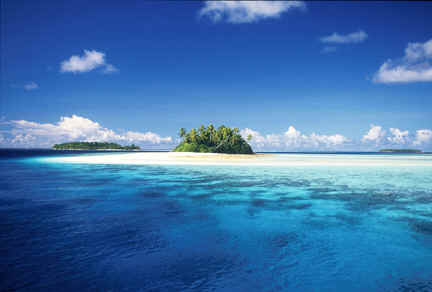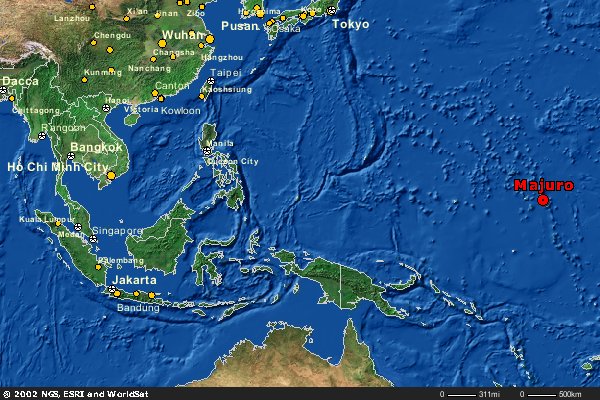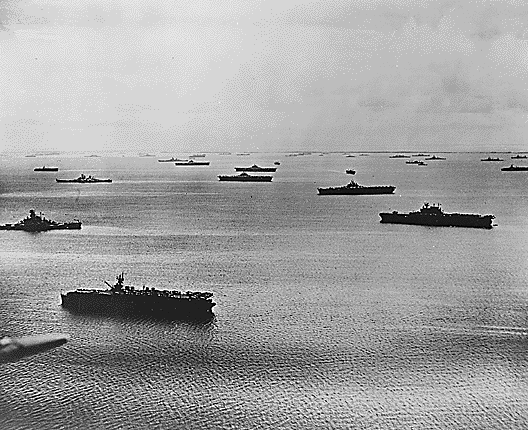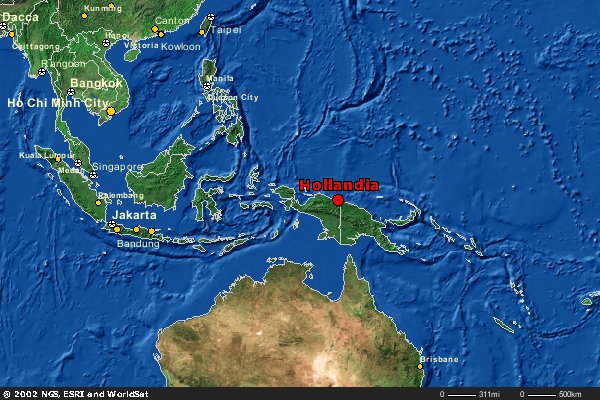CHAPTER THREE
THE MARSHALLS CAMPAIGN
The New Year was welcomed in a fashion somewhat different from that to which most Abboteers were accustomed. The warm climate, some sore spots still noticeable from having gone through the ritual of becoming shellbacks, and most important of all, the very few hangovers to be noted made this particular New Year an outstanding one.
At Funafuti we got our first taste of “No Letter Today.” From 21 December until 6 January, 16 long days, we went with nary a line from home. And did Woosley, SM1c, our genial mail clerk, take a beating! We had piles of rejects in our letter writing at this time, because this was our first introduction to strict security regulations.
We had all kinds of inspections, including the nod from Commodore Bottom, our squadron commander.
Everyone at this time was trying to find an excuse to go to the Cascade, a destroyer tender, to get cokes and “pogey bait.” We had movies nearly every night, plenty of swimming, first aid lectures, and drills of every description; all in preparation for the coming Marshall Islands campaign. One abandon-ship drill was made much more realistic by Paredes, RM3c, nearly drowning ten feet away from the ship. Firing exercises were a regular routine, and were quite different from those previously conducted at the “Anchor” or the “Rex.” Mr. Miller, our First Lieutenant, supervised a tear gas drill in the after head during this period.
At 0630 on 23 January, we were off to war. No more USO liberties, no movies on the forecastle for a while, no extra sack time, no more always-looked-for mail. Eight battlewagons, the Indiana, New Jersey, Massachusetts, Washington, South Dakota, Alabama, Iowa and North Carolina, three cruisers, two carriers and fifteen destroyers comprised the bombardment unit which left Funafuti. The Chester (CA27) was forced to return to port, and the “A” was assigned her first of many underway duties involving great risk. We transferred the late Rear Admiral E. J. Small, USN, via the “coal bag” from the Chester to the Salt Lake City (CA25). Later, we joined other task units for our first big push.
Do you recall the word being passed about the full uniform of the day with life, jackets on at all times? At this you became a little jittery, sleeping with all your clothes on plus the life jacket, and you wondered if that were not the safest way, usually spending more time worrying than you did sleeping.
On 27 January we were 120 miles from the Jap possessed Ocean Island, and very much on the alert. All hands became lookouts, for there was a fifty dollar prize awaiting the person who spotted the first Jap craft. On the 28th, we dropped 33 depth charges (ash cans to the sailor), and what appeared to be a definite submarine contact. Everyone spotted debris — that is, a lot of TNT residue — but no definite claims were made. One of our search planes spotted an oil slick near the spot the next day, so we may have crippled him.
During predawn alert on 29 January, the Bunker Hill was launching planes about two miles dead ahead of our formation. Two planes crashed in mid air during the exercises. Later word was revealed that Raymond Clapper, news commentator, had been killed in this crash. There were no survivors.

Ray Curran, Y2c, won the fifty bucks at 1128 on 29 January when he spotted on the horizon a Jap Betty, (a twin-engined bomber). We knew now that we were getting closer to the war, and everyone was as excited as a cat on a tin roof in distress. Noon chow was served at battle stations by the repair parties. We couldn’t afford to take any chances. Wotje Atoll was sighted at 1344 and the Salt Lake City opened fire shortly afterward. One Jap plane tried to make off from the island runway but was shot down by our combat air patrol.
The “A” took her first shot at enemy held territory, Wotje Atoll, at 2115 on 29 January, firing from that time until 0315, lofting a total of over 500 rounds of 5 inch ammunition on the Nips. At 2230 during this bombardment, our radar picked up an unidentified surface target, and after four guns had expended 83 rounds of 5 inch shells in less than two minutes, the target was no more. We didn’t stick around to observe results, but have our own ideas that we may have “nipped the Nips.” Anyhow, we are certain that it was war bonds well spent.
On the night of 1 February we shelled Taroa Atoll in the Marshalls from 2250 until 0250, firing 262 rounds of 5 inch ammunition. During this bombardment, at 2120, flashes were observed from the beach. A few seconds later, large spouts of water were visible about 1000 yards off our starboard quarter. “They are firing back at us” sounded over all the ship’s phone circuits. Seven splashes were certain, falling 1000 yards off our starboard side, but that was close enough. Captain Dornin ordered flank speed and we increased range to play safe, but continued on another firing run as if nothing had happened.
While we were not bombarding, our time was occupied in screening cruisers while they in turn shelled the beaches. No landings were made on either Wotje or Taroa and the Jap garrisons there were bypassed, to be harassed again and again by our bombers.
We entered Majuro lagoon in the Marshalls, on 4 February, a Yank possession of only a few days. We rated a star on that campaign bar! We were practically winning the war by ourselves! We had a movie on the forecastle that night with the Japs still on Jaluit Atoll, only 50 miles away.

After replenishment of all our “vitels,” we were back at Wotje on 6 February and our contribution to the war effort between 6th and 12th of February lay in volleying a few more shells night and day on Wotje and Taroa, at one time getting so close that Captain Dornin asked for permission to strafe the beach with 40 mm. “Permission not granted” was the reply. Our Seabees, “Chips” Johnson, CM2c, Burton, SF1c, and Reimer, S1c, had ideas of forming a landing force on several occasions.
After taking on stores at Majuro, we returned to Wotje and Taroa, carrying our around-the-clock bombardments until the 19th, when we again returned to Majuro for repair and upkeep alongside the Prairie (AD15), a tender. We were treated to the facilities of the tender until the 26th, received some mail again, and saw some good movies, although the greater number were war bond sellers. We got underway for Kwajalein on the 26th with our squadron, arriving there on the 27th. During the period spent here, we alternated with other ships on patrol duty outside the lagoon entrance until 4 March, when we returned to Majuro, arriving on the fifth. Lieutenant Commander Gabbert, our well liked Executive Officer, received orders to command the Bell (DD587) to be effected 1 April. Egstad, CMM, was appointed to Warrant Machinist.
On the 6th a liberty party was granted, the first since we had left Pearl Harbor three months before. The men of the “A” still talk about chasing the wild chickens and hogs. This was a far different liberty from what a sailor is accustomed to, but there weren’t any women to chase.

BECKHAM and HODGES, two of our starving seamen that never got enough to eat, considered themselves very fortunate when they discovered a nest of ten eggs on “liberty” island. This was their chance to eat fresh eggs, they thought; so when they returned to the ship, the eggs were carefully placed in Hodges’ locker in anticipation of “sunnysides up.” A few days later when the chow was off par, Hodges decided to get the needed vitamins, but upon opening his locker he found “chicken” instead. During the next week seven of the ten eggs hatched and the chicks became good sailors. After finishing their “boot training aboard” of a months’ duration, they became quite a problem and were transferred to shore duty at Buna, New Guinea on April 5. With this incident the Abbot became the first ship to transfer poultry from one Pacific Island to another.
Preparing for coming operations, we again had captain’s inspection.
On 12 March we were underway for Espiritu Santo, New Hebrides, but on the 13th our orders were changed and we headed for Guadalcanal in the Solomon Islands, crossing the 180th meridian at 1900 on this date. It is still debated as to whether we gained or lost a day when the date was advanced to the 14th. We entered the historical Florida-Guadalcanal-Savo Island area, early on the 17th and anchored near Henderson Field, changing berths later in the day to Port Purvis, Florida Island.
On 20 March we were fortunate enough to get our first beer since leaving Pearl Harbor. This was getting to be the Navy that we had heard about! Four good cold beers! On the 22nd we presented a variety entertainment program while alongside the Hale (DD642), only to have the always welcome, cooling rain spoil our evening at the Abbot “theatre.” We were underway again on the 23rd, screening transports that were taking on men and supplies from Guadalcanal Island for future landings. We were steaming in “Iron Bottom Bay,” so named because of the large number of ships, both theirs and ours, (mostly theirs), which were sunk in surrounding waters.
On the 26th we were underway for Bouganville, arriving at Cape Torokina on the 29th, having screened the loaded transports on the trip. We patrolled the entrance to the bay while the transports unloaded, and started for Port Purvis again that evening. Our orders were changed, however, and we headed for Milne Bay, New Guinea, where we anchored on the 31st.
We remained in Port long enough to resupply, getting underway for Buna, New Guinea, on 4 April, anchoring on the morning of the 5th in Cape Sudest Harbor. We had beach parties here, but everyone was satisfied to return to the “A,” as the beach life was very disagreeable indeed. We had inspections again during this period in port.

We got underway again on 10 April for Port Purvis, arriving on the 12th. While underway, on the 11th, Pelletier, E. A., S1c, underwent an appendectomy in the wardroom, performed by our “always willing to please” Dr. Mrazek.
We left Port Purvis on the 14th, our assignment being to relieve destroyers of a task unit patrolling Jap supply lanes between Truk and Rabaul. We spent the next five days in this area, and then joined other task units to conduct air strikes preparatory to landings at Humboldt Bay, Hollandia, New Guinea. Air strikes began on the 22nd on Hollandia and Aitape. Our forces went ashore at Hollandia, on the 23rd at 0642. They found the opposition light.
The 23rd was the first birthday of the “A” and the chow was extra special. We had movies underway for the first time during this operation. The mess hall was converted into the “theatre.”
With the exception of one short trip to Manus Island, we remained in the Hollandia vicinity for continuation of air strikes until 4 May, at which time we returned to Seeadler Harbor, Manus Island, in the Admiralties.